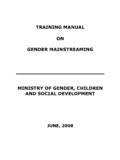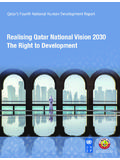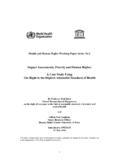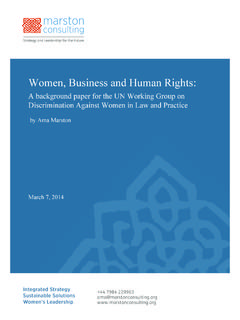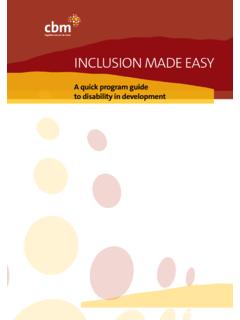Transcription of MINISTRY OF GENDER, CHILDREN AND SOCIAL …
1 MINISTRY OF gender , CHILDREN AND SOCIAL DEVELOPMENTDEPARTMENT OF gender AND SOCIAL development MONITORING AND EVALUATION FRAMEWORK FORGENDER MAINSTREAMINGMARCH, 20093 TABLE OF CONTENTSLIST OF ACRONYMS AND AND BACKGROUND .. Background of gender Department .. The Concept of gender mainstreaming .. Basic Principles of mainstreaming .. Strategies in gender mainstreaming .. Definitions of the terms monitoring and Rationale for Developing an M & E Framework .. Objectives of the M &E Framework .. Methodology .. Situation analysis of the current M&E Framework.
2 M&E FRAMEWORK FOR gender mainstreaming .. Purpose and Scope of the M&E Performance Questions, performance indicators and information needs Performance Questions and Information needs mapping .. Performance Indicators .. Performance Indicators Matrix for gender mainstreaming M&E Framework .. Data collection, processing and Reporting Framework and dissemination .. Reporting Framework .. Communication / Dissemination of Reports .. / Necessary Conditions and Capacities for M& M&E Institutional Framework .. Computer equipment and Human Resource .. Implementation and coordination of the gender mainstreaming M&E Framework.
3 Commission on gender and development , Department of gender and SOCIAL Services, and Office of gender Secretary .. gender Officers in Ministries, Parastatals and Institutions of Higher Learning .. : Provincial gender and SOCIAL development Office, District gender and SOCIAL development Office .. development Partners .. Underlying M& E Framework Assumptions ..24 ANNEX 1: BIBLIOGRAPHY ..26 ANNEXE 2: PROPOSED LOWER LEVEL MONITORING INDICATORS ..27 ANNEX 3: TERMS OF REFERENCE ..29 ANNEX 4: M & E FRAMEWORK FLOW AND DATA BANK ..30 ANNEXE 5: COMMONLY USED 6: PROPOSED REPORTING 7: LIST OF ATTENDANCE ..34 ANNEXE 8: LIST OF INTERVIEWEES.
4 374 LIST OF ACRONYMS AND ABBREVIATIONSCBO sCommunity Based OrganizationsCEDAWC onvention of the Elimination of All forms of Discrimination against Women CPPMUC entral Planning and Project Monitoring UnitDGDSOD istrict gender and SOCIAL development OfficerECOSOCU nited Nations Economic and SOCIAL CouncilEACEast African CommunityKNBSK enya National Bureau of StatisticsILOI nternational Labour OrganizationNGONon-Governmental OrganizationM&EMonitoring and EvaluationNCAPDN ational Coordination Agency for Population DevelopmentNEPADNew Partnership for African DevelopmentNIMESN ational Monitoring and Evaluation systemTWGT
5 Echnical Working GroupUNUnited NationsUNDPU nited Nations development AND BACKGROUNDThe United Nations Economic and SOCIAL Council (ECOSOC July 1997) defined the concept of gender mainstreaming as: "..the process of assessing the implications for women and men of any planned action, including legislation, policies or programmes, in any area and at all levels. It is a strategy for making the concerns and experiences of women as well as of men an integral part of the design, implementation, monitoring and evaluation of policies and programmes in all political, economic and societal spheres, so that women and men benefit equally, and inequality is not perpetuated.
6 The ultimate goal of mainstreaming is to achieve gender gender equality was officially recognized as a global goal for economic growth and poverty reduction by the world community (in the Charter of United Nations) in 1945. It was adopted on 7thNovember 1967 by the UN General Assembly of the Declaration on Convention of the Elimination of All forms of Discrimination against women (CEDAW) and entered to force as an international treaty on the 10th Anniversary in 1989. The spirit of the CEDAW is rooted in the goals of the United Nations: to reaffirm faith in fundamental human rights, in the dignity and worth of the human person, in the equal rights of men and women.
7 This has been confirmed by subsequent international and regional treaties, conventions and agreements/instruments that promote gender equality and gender equity of which Kenya is a signatory. Kenya signed and ratified CEDAW in 1984; the BPFA in 1995; is committed to MDGs (2000) which are consistent with the 12 critical areas of concern in the BPA; the resolution of African Union Summit (September 2004) on employment creation and poverty alleviation; Convention of the Rights of CHILDREN (CRC) 1989; United Nations declaration Violence Against Women(1993); International Conference on Population and development (ICPD)1994; Nairobi Forward Looking Strategies for the advancement of women (NFLS)-1985.
8 And NEPAD-Peer review mechanisms, African Union(AU) and the East African Community(EAC) Partnership Treaty; among others. In addition, Kenya has ratified two core labor standards of the ILO: Convention on equal pay for work of equal value and Convention on Discrimination (Employment Occupation Convention 1968). The commitment of the Government of Kenya to mainstream gender in national development for equitable growth and poverty reduction is evidenced by the establishment of different national machineries with different but complementary roles. In Kenya, gender mainstreaming has continued to be a challenge at both national and community levels despite efforts put in place by the Government.
9 Assessments undertaken in the past indicate that gender mainstreaming in the public, NGO and private sectors has been weak both at national and community levels. Various factors have contributed to this shortcoming key among them being lack of an effective monitoring and evaluation framework which are an integral part of the implementation programme. Background of gender DepartmentThe MINISTRY of gender , CHILDREN and SOCIAL development is the national machinery assigned with the responsibility of implementing gender mainstreaming in policy formulation, planning, budgeting, monitoring and evaluation.
10 The MINISTRY was curved out of the then MINISTRY of gender , Sports and SOCIAL Services under the Presidential Circular No 1 of May 2008. Specifically the MINISTRY is to promote gender mainstreaming in national development processes, co-ordinate and 6harmonize the implementation of the National Policy on gender and development 2000 as stipulated in the National Plan of Action (2008-20012). The MINISTRY comprises two departments namely Department of gender and SOCIAL Services and the Department of CHILDREN Services. The Broad functions of the MINISTRY include: Formulating polices in gender , CHILDREN and SOCIAL development ; gender mainstreaming into National development ; Promotion and Coordination of volunteer services; Promotion and coordination of volunteer services as well as provision of SOCIAL welfare and; Guiding community development and supervising programmes and institutions for CHILDREN s care department.
